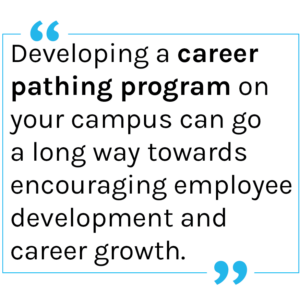Employee development is key in HigherEd.
It’s vital to focus on skill development to make sure that employees—whether faculty, staff, or administrators—are able to achieve their full potential in their careers and at your institution. Robust employee development programs are also an important factor in employee engagement. With retention top of mind for many institutions today, employee development and learning should definitely be on the radar. Below, we’ll break down professional development and share a few ways you can focus on employee development at your institution.
What is employee development?
Employee development, or professional development, is essentially learning at work, for work. Employees focus on improving or expanding their skills and knowledge, whether for their current role or to focus on career growth. Professional development benefits both the employee and the institution. It helps employees feel more engaged and valued, and build their careers, while it helps institutions hold onto the employees they already have and get better performance out of employees whose skills are increasing. Employee development can include workshops, courses, webinars, conferences, and more.
How can we encourage employee skill development at my institution?
HigherEd may be unique from other workplaces in a lot of ways, but your team can leverage some of the same techniques that other businesses use to develop people on your campus.
- Have managers help employees create development plans. You can base these off of job descriptions or career goals, and set goals surrounding employee learning. Managers should reference these plans frequently to encourage their employees to engage with development.
- Offer institution-wide development. Don’t just rely on your employees to seek out learning opportunities. Instead, offer courses on campus, create an institution-wide program that all employees can participate in, and create communities around this learning so that it becomes part of campus culture.
- Broaden your definition of employee development. Some institutions offer part-time positions as a form of staff development—for instance, coaches who have a secondary role in student affairs, broadening their skill set. Encourage employees to join professional organizations, or to seek out mentors.
- Don’t make it optional. Requiring some form of professional development can be a great way to ensure that all employees reach their full potential. You institution can explore making professional development and goal setting part of the performance review process, requesting that employees fulfill a certain number of hours, or proactively creating campus-wide professional development days.

- Create career paths. Developing a career pathing program on your campus can go a long way towards encouraging employee development and career growth. Not only does it help build an internal talent pipeline that makes hiring easier and quicker, but it helps build a culture of retention when employees have a clear avenue for growing their career internally.
- Don’t forget about faculty! A huge factor in retaining faculty members is professional development. The Chronicle of HigherEd notes that supporting faculty to thrive professionally and meet their fullest potential should involve offering workshops, webinars and online courses, sponsoring professional development, and encouraging career growth within the institution.
Final Thoughts
Whether you’re focusing on faculty or staff, workshops or courses, conferences or mentors, employee development should be central to your institution’s retention efforts. Don’t underestimate the benefits of employee skill development and professional learning to both your faculty and staff and your institution.
PeopleAdmin can help! With Professional Development and Learning, you can make employee development easy, drive engagement and retention, and build personalized learning paths.